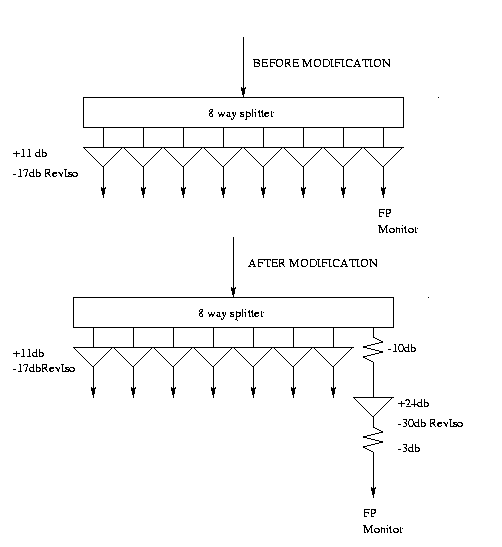Increasing the isolation in the downstairs 260 MHz monitor ports.
23apr03
PLOTS:
The
bandpass change (on/off-1) caused by changing the FP load.
Injecting
a -20dbm tone into the FP ports.
The downstairs if/lo has an 8 way splitter/buffer
amplifiers for each of the 8 sub bands that can be generated (4 for polA,
4 for polB). The frequency range is 0 to 500 Mhz and can be sent to
7 back end devices. The eighth channel is a front panel monitor port that
is normally used for the spectrum analyzer. It is also used to take data
with the radar interface (ri) a/d system. The front panel output has caused
ripples in the spectra of the correlator if a cable/device was connected
or disconnected during an observation.
Lisa Wray modified the front panel output on 23apr03
to improve the isolation. The before and after setup is shown below...

The power for a transmitted and then 100% reflected signal was 11db
- 17db = 6db.
After the change the power was : -10db+24-3-3-30-10=-32 db. The difference
is 26 db (twice the attenuators added since the amps have the same ratio
of gain to reverse isolation).
The correlator is connected to the output adjacent to the front panel
(FP) output.
On/Off measurement changing the load on the monitor port.
To measure the improvement, data was taken using the correlator and a 25
Mhz bandwidth on buffer amplifiers 1 and 2 using both polarization's. Band1A
FP had its amplifier modified. The other 3 bands (band2a, band1b,band2b)
used the old setup. The isolation for band1A and band2a were
measured by placing two unterminated 5 Mhz BW, 260 Mhz cfr filters
on their FP ports. band1b and band2b FP ports were left open. Data
was taken for 300 seconds on the 4 bands (call this the on). The filters
were then removed from bands1a,2a and another 300 seconds of data
was taken (call this the off). The average of the 300 second integrations
were computed and then on/off-1 was computed.
The plot
shows the change in the bandpass shape (on/off-1) caused by changine
the FP load. On/off-1 is plotted (units become fractions of Tsys). The
black traces had the inputs to the FP ports changed. The red traces were
left open the entire time.
-
Fig top. This is band 1. The black polA has lisa's new modification while
the red (polB) has the old setup. Black had its input changed between the
on and the off, red was left unchanged.
-
Fig bottom. This is band 2. Both the black (polA) and the red (polB) have
the old setup. The black had its input changed between the on and the off.
The red was kept constant.
You can easily see the ringing from the filter in the
bottom plot (before the change). The maximum ripple is about .04 Tsys.
The black top plot with lisa's change still has the ripple but at a reduced
level. The maximum amplitude is now .0025Tsys. The maximum ripple has decreased
by 12db.
The decrease is not as large as the change in the
power for a signal that traversed the path and then had a100% reflection.
addendum.. jon hagen pointed out that you
have to follow the voltage through the path and then add this to the volaage
that got sent directly to the correlator. The power difference along the
path was 32 db. The voltage difference would have been half of this in
dbs. Call this deltaV. If you add this to the value that went directly
to the correlator (using units of Tsys=1) and then square it to get the
voltage you get:
powerRipple(units Tsys)= (1+deltaV)^2= 1 + 2*deltaV + deltaV^2 .
Since deltaV is small you can ignore delatV^2. The ripple size
will be 2*deltaV. The ratio of before and after should then be the 2*deltaV1/2*deltaV2
. This is 13 db (or one pass through the attenuation added). The measured
value was about 12.
Injecting a -20dbm tone into the front panel port.
A second test was done by injecting a -20dbm tone into
the FP port. The correlator was set to 300 hz resolution. The plots
show how far the tone stood up above the noise floor. The noise floor
of the 8 bands were probably within a few db of each other.
-
Fig1 top. PolA sbc 1,2,3,4. Each plot is scaled to the tone peak and then
converted to db's. The flat line is Tsys.
-
Fig 1 middle. PolB sbc 1,2,3,4.
-
Fig 1 middle. The strength of the tone above the noise floor is plotted.
PolA is black and polB is red. sbc1A has had the modification.
processing: x101/030423/doit.pro
home_~phil
